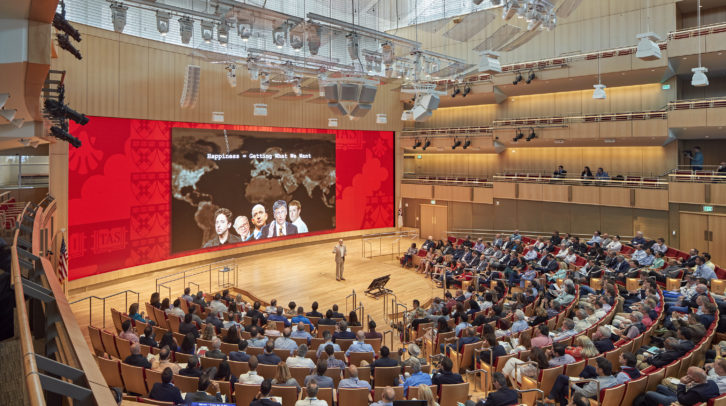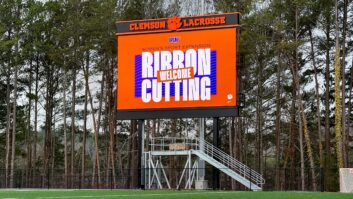
Harvard Business School has opened a multipurpose auditorium at its campus in Allston, Massachusetts, which includes an 18.8m-wide curved display from SiliconCore Technology.
Klarman Hall, designed by William Rawn Associates, Architects, Inc. and made possible by a gift from Beth and Seth Klarman (MBA 1982), seats up to 1,000 people across three tiers, providing an inspiring space for large scale events. The venue has been designed to emphasise sustainability and technological innovation and the floor plan allows it to be set up for smaller scale events as well.
The focal point of the auditorium is a 116sqm digital canvas from fine pixel pitch display innovators SiliconCore Technology. Specifying a 1.9mm pixel pitch, the 18.8m-wide by 6.2m-high (61.8 by 20.2 feet) LED display is built onto a custom frame from mounting specialists RP Visual Solutions. In order to accommodate viewing distances ranging from 5 to 40 metres, the display has been designed with a subtle curve to optimise viewing angles.
AVI-SPL, who oversaw the project alongside Idibri (AV design engineer), installed an audio system of ultra-sensitive microphones and more than 100 speakers to create a uniform sound across the auditorium. A complex wireless network includes 80 wireless Ethernet access points, 32 antennas in the auditorium ceiling, and multi-gigabit Ethernet uplinks throughout the building. The second story and lower-level concourse feature studios to support podcasts, webinars, online learning and a black box room for videotaping the HBS digital learning platform, HBX.
Eric Li, CEO of SiliconCore Technology commented: “This is a very prestigious application of our technology, in a higher education facility which is highly regarded across the globe. We pride ourselves on creating products that push the technology to perform at its peak, while also ensuring a long life for the display. The brightness and viewing angles of the LED display work particularly well for this multi-use auditorium setting, for content to be viewed from the closest to the furthest viewer.”
In a drive to create a sustainable environment for all who use the space, Klarman Hall follows the University’s guidelines for sustainable building products and materials. The building serves as both a living lab and model for large corporations, helping to transform the marketplace by proving that greener products can be manufactured and sourced with little to no effect on project delivery, cost, or operational performance.
The digital display also had to meet stringent audible noise emission and sustainability requirements set by Harvard Business School. Advanced testing conducted by SiliconCore engineers ensured no audible noise generated by the LED screen would be detected by the ultra-sensitive microphones located close to the screen. SiliconCore’s proprietary Common Cathode technology, which has a significant effect on the operating temperatures and power consumption of the display was pivotal in meeting this requirement. Along with the audible noise reduction, this proprietary technology prolongs the display’s lifespan, increases brightness and reduces the power requirements by up to 40%, leading to lower operating costs.
University Lecturers can easily connect devices to the screen via HDMI, while the display can be fed with SDI sources, such as cameras operated from the auditorium’s control room. For ease of displaying multiple windows of mixed media at once, the system includes a Christie Spyder X80 windowing processor. The system can handle the 32-million-pixel resolution of the display, enabling multiple 4K sources to be displayed on the screen simultaneously. High resolution content is specifically created for landmark shows and presentations.
The display also features SiliconCore’s Z.A.C.H. technology to enhance HDR capability and achieve unmatched low grayscale performance even at very low brightness levels. The LED screen brightness can be adjusted via a Crestron controller, making it easy for staff to operate the screen at the optimum brightness.







